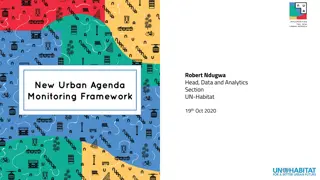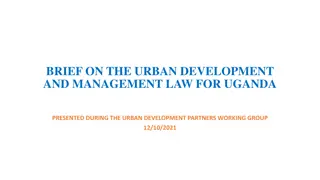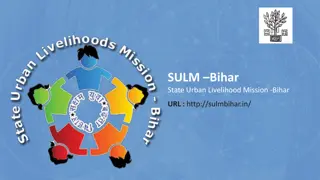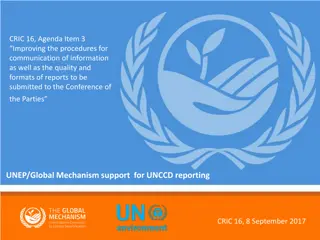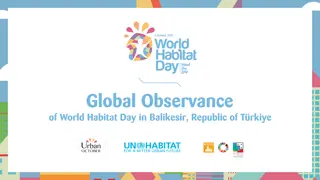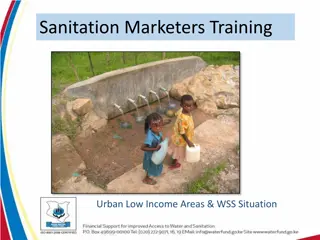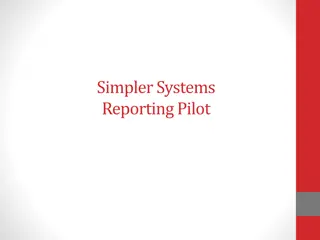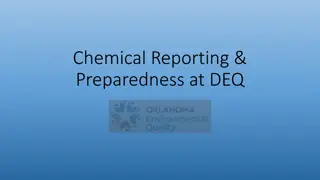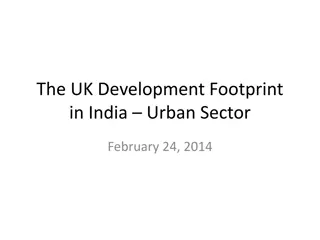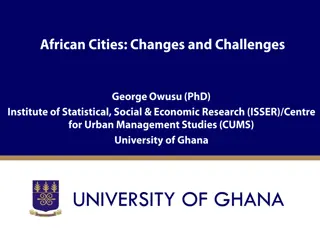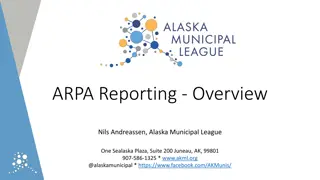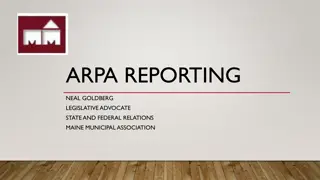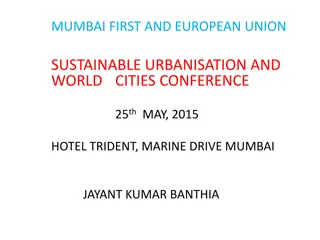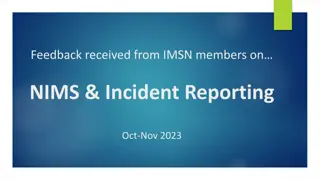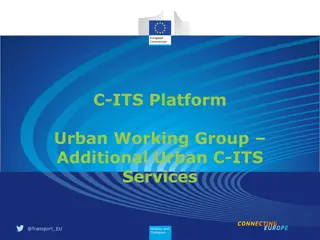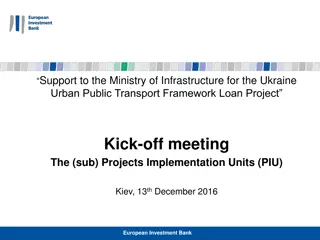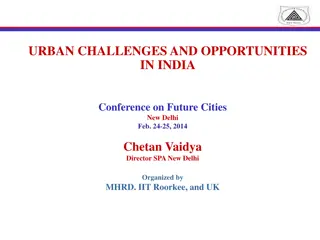Guidelines for Reporting on the Implementation of the New Urban Agenda
The guidelines emphasize the importance of periodic follow-up and review of the New Urban Agenda by Member States to ensure effective implementation. They stress inclusivity, transparency, and voluntary participation in tracking progress towards sustainable urban development goals. The document outlines transformative commitments including social inclusion, ending poverty, sustainable urban prosperity, and environmentally resilient development. It also highlights key aspects such as urban governance, spatial planning, and financial mobilization for successful implementation.
Download Presentation

Please find below an Image/Link to download the presentation.
The content on the website is provided AS IS for your information and personal use only. It may not be sold, licensed, or shared on other websites without obtaining consent from the author. Download presentation by click this link. If you encounter any issues during the download, it is possible that the publisher has removed the file from their server.
E N D
Presentation Transcript
Guidelines for Reporting on the Implementation of the New Urban Agenda
In the New Urban Agenda document, Member States are requested to: carry out a periodic follow-up to and review of the New Urban Agenda in order to track progress, assess impact and ensure the Agenda s effective and timely implementation (paragraph 161). encourage voluntary, country-led, open, inclusive, multilevel, participatory and transparent follow-up and review of the New Urban Agenda (paragraph 162). the General Assembly to request the Secretary-General, with voluntary inputs from countries to report on the progress of the implementation of the New Urban Agenda every four years (paragraph 166). the report will provide a qualitative and quantitative analysis of the progress made in the implementation of the New Urban Agenda and internationally agreed goals and targets relevant to sustainable urbanization and human settlements (paragraph 167). 2
1.1 Sustainable Urban Development for Social Inclusion and Ending Poverty Social Inclusion and Ending Poverty Access to Adequate Housing Access to Basic Services Part 1: Transformative Commitments 1.2 Sustainable and Inclusive Urban Prosperity and Opportunities for All Inclusive Economy Sustainable Urban Prosperity for All 1.3 Environmentally Sustainable and Resilient Urban Development Resilience, Mitigation and Adaptation of Cities and Human Settlements Sustainable Management and Use of Natural Resources 2.1 Building the Urban Governance Structure: Establishing a Supportive Framework Part 2: Effective Implementation 2.2 Planning and Managing Urban Spatial Development 2.3 Means of Implementation Mobilization of Financial Resources Part 3: Follow Up Capacity Development Structure Information Technology and Innovation 3
1.1 Sustainable Urban Development for Social Inclusion and Ending Poverty Social Inclusion and Ending Poverty 1. 2. 3. 4. Eradicate poverty in all its forms Reduce inequality in urban areas by promoting equally shared opportunities and benefits Achieve social inclusion of vulnerable groups (women, youth, older persons and persons with disabilities and migrants) Ensure access to public spaces including streets, sidewalks, and cycling lanes Access to Adequate Housing 1. 2. 3. 4. Ensure access to adequate and affordable housing Ensure access to sustainable housing finance options Establish security of tenure Establish slum upgrading programmes Access to Basic Services 1. 2. 3. Provide access to safe drinking water, sanitation and solid waste disposal Ensure access to safe and efficient public transport system Provide access to modern renewable energy Part 1: Transformative Commitments 4
1.2 Sustainable and Inclusive Urban Prosperity and Opportunities for All Inclusive Economy 1. Promote productive employment for all including youth employment 2. Support the informal economy 3. Support small- and medium-sized enterprises 4. Promote an enabling, fair and responsible environment for business and innovation Sustainable Prosperity for All 1. Diversify the urban economy and promote cultural and creative industries 2. Develop technical and entrepreneurial skills to thrive in a modern urban economy 3. Strengthen urban-rural linkages to maximize productivity Part 1: Transformative Commitments 5
1.3 Environmentally Sustainable and Resilient Urban Development Resilience, Mitigation and Adaptation of Cities and Human Settlements 1. Minimize urban sprawl and loss of biodiversity resulting from it 2. Implement climate change mitigation and adaptation actions 3. Develop systems to reduce the impact of natural and human-made disasters 4. Build urban resilience through quality infrastructure and spatial planning Sustainable Management and Use of Natural Resources 1. Strengthen the sustainable management of natural resources in urban areas 2. Drive resource conservation and waste reduction, reuse, and recycling 3. Implement environmentally sound management of water resources and urban coastal areas 4. Adopt a smart-city approach that leverages digitization, clean energy and technologies Part 1: Transformative Commitments 6
2.1 Building the Urban Governance Structure: Establishing a Supportive Framework 1. Decentralization to enable subnational and local governments undertake their assigned responsibilities 2. Link urban policies to finance mechanisms and budgets 3. Develop legal and policy frameworks to enhance the ability of governments to implement urban policies 4. Build the capacity of local and subnational governments to implement local and metropolitan multilevel governance 5. Implement participatory, age- and gender-responsive approaches to urban policy and planning 6. Promote women s full participation in all fields and all levels of decision-making Part 2: Effective Implementation 7
2.2 Planning and Managing Urban Spatial Development 1. Implement integrated and balanced territorial development polices 2. Integrate housing into urban development plans 3. Inclusion of culture as a priority component of urban planning 4. Implement planned urban extensions and infill, urban renewal and regeneration of urban areas 5. Improved capacity for urban planning and design, and training for urban planners at all levels of government 6. Strengthening the role of small and intermediate cities and towns 7. Implement sustainable multimodal public transport systems including non-motorized options Part 2: Effective Implementation 8
2.3 Means of Implementation Mobilization of Financial Resources Capacity Development 1. Financial frameworks for implementing the NUA at all levels of government 1. Expand opportunities for city-to-city cooperation and fostering exchanges of urban solutions 2. Mobilize endogenous (internal) sources of finance and expand the revenue base of subnational and local governments 2. Capacity development as a basis to formulate, implement, and manage urban development policies 3. Promote sound systems of financial transfers from national to subnational and local governments based on needs, priorities and functions 3. Capacity of governments to work with vulnerable groups to participate in urban planning and development 4. Support local government associations as promoters and providers of capacity development 4. Mobilize and establish financial intermediaries for urban financing Information Technology and Innovation 5. Capacity development programmes on the use of legal land-based revenue and financing tools 1. User-friendly, participatory data and digital platforms such as e- governance and citizen-centric digital governance tools 6. Capacity development programmes of subnational and local governments in financial planning and management 2. Digital tools, GIS, etc., to improve urban and territorial planning and access to urban services 7. Knowledge exchange on science and innovation for sustainable urbanization 3. Strengthen capacities of governments to effectively monitor and implement urban policies Support governments in the collection, disaggregation, and analysis of data Part 2: Effective Implementation 4. 9
Part 3: Follow Up + Review Methodologies/mechanisms that have been developed to monitor and report on the implementation of the New Urban Agenda Part 3: Follow Up + Review 10
Preparing the Report Led by the key ministry, or a clearly defined consortium of ministries, dealing with urbanization National Habitat Committees and National Urban Forums can play a key role or take the lead in preparing the Report. Country-led, open, inclusive, multilevel, participatory, and transparent process The team preparing the Report should include the following: National Government, represented by the key ministries and institutions Local Governments, including their national associations Regional Governments, which includes provincial, county or state governments; Civil Society and the Private Sector, including NGOs, the media, professional societies, the private sector, women s and youth groups, minorities and special interest groups; Academic Institutions External Support Agencies, including bilateral and multilateral donors, the United Nations, international NGOs, and other support agencies. 11



